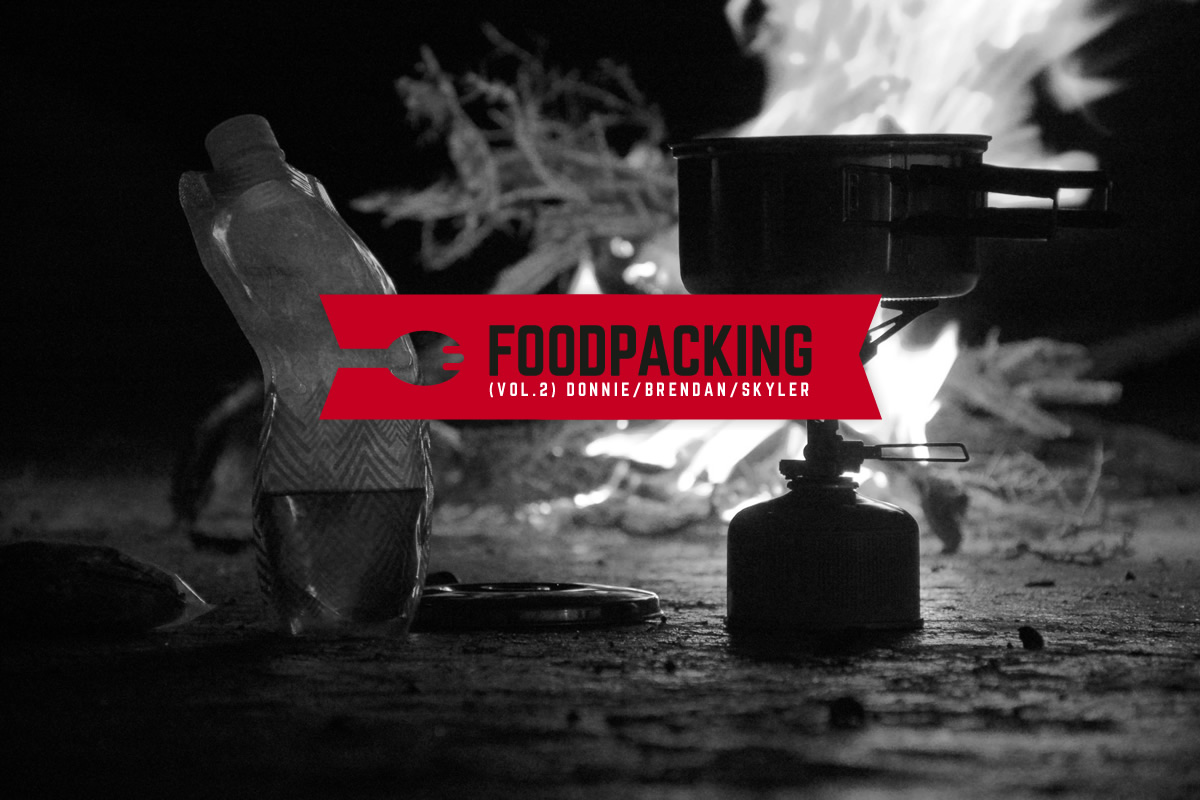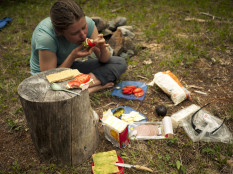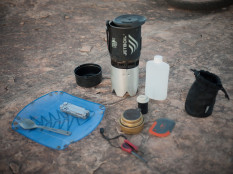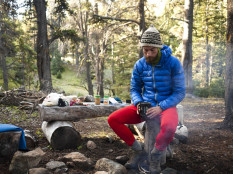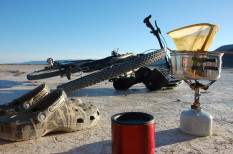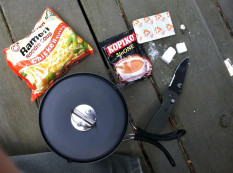Foodpacking (Vol. 2): Bikepacking Food by Brendan, Skyler & Donnie
How do riders plan their bikepacking food pack list, pack it, and cook on a bikepacking trip? Volume 2 continues the exploration with thoughts and packlists from Brendan Collier, Skyler Des Roches, and Donnie Kolb…
In the first post of the foodpacking series we heard from Glenn Charles, Joe Cruz, and Eszter Horyani. Volume 2 continues the exploration of how bikepackers eat when they are out on the typical long weekend (three day) trip. On the menu: Brendan Collier, Skyler Des Roches, and Donnie Kolb:
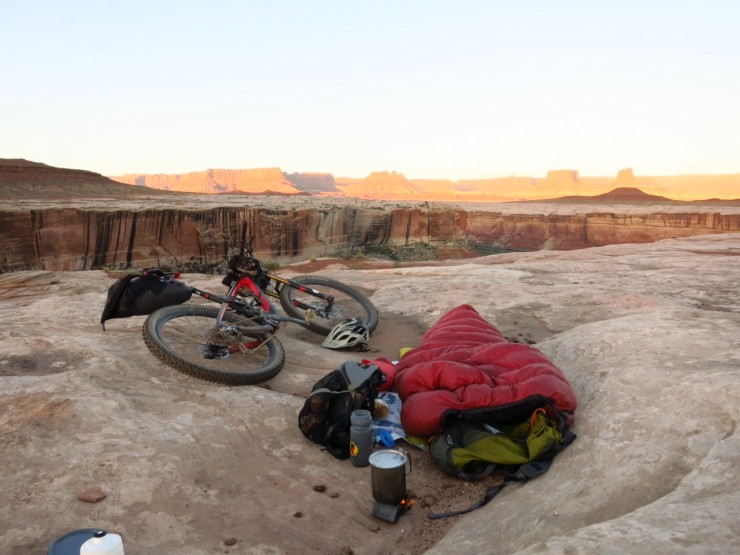
Brendan Collier
Brendan is co-owner and operator of The Hub Cyclery, a bikepacking-focused shop in Idylwild, California. Brendan also founded and started the famed bikepacking route, the Stagecoach 400.
For me, there is no standard food packout, just as there isn’t really a standard gear packout for a bikepacking trip. I have wild variation in my bikepacking menu from one trip to another. The route, the crew I’m headed out with, and even my own fitness level are all factors to consider. On some trips I might be able to carry heavier, more luxurious gear such as a proper camp stove, but on other trips I might need to keep the packing lighter & simpler for less time and effort. And everything in-between.
Touring Pace, Riding With Friends
These are the trips when many of us in the Idyllwild bikepacking crew like to wow one another with delicious treats in camp.
Divy up the (work)load.
Bring real food
Marlin packs cold pizza for dinner. Since it’s flat it can fit in just about anywhere, even in frame bag. He’s also carried a block of parmesan, which keeps exceptionally well and can be a tasty mid-day treat on crackers or with slices of apple.
Take advantage of the freezer
Pack sturdy fruits & vegetables
Sturdy staples
Raid the bulk aisle
Eat the heavy stuff first
Baking
Bikepack Racing or Big Personal Efforts
When I’m going light & fast, I might only carry “robot food” and other items we likely won’t find on the route.
Remove wrappers, and pre-portion your robot food
Mix your pills into water
Start your day off with a clear head
Nuts, I’m going nuts
On the bike, I eat a lot of nuts. Mixed nuts and trail mix with some M&M’s give good long-burn energy and are very satiating for a grumbly belly. More recently I have come to enjoy a product called Trail Butter, which we carry at the shop. (we haven’t put it on the online store yet, otherwise I’d link to it here) Made from nuts, dried fruits, and other goodies such as maple syrup or espresso, these squeeze packets carry more than 700 calories in a 4 ounce pouch with a resealable cap. They’re easy to pack in a handlebar bag or pocket and have saved me from many rough afternoons. They cost about 5 bucks and keep very well.
A cheese sandwich (on bread or even a burrito) does me well, packs nicely and keeps for at least a full day. When I pass by a store I might pick up a can of chicken noodle soup and drink it on the spot. Calories, fluids, and much-craved salt all in one easily digested package.
Fritos
Get robot food on board as soon as you stop
Emergency food

Skyler Des Roches
Skyler Vancouver based climber, bikepacker and ski mountaineer. Follow Skyler’s travels at OffRoute.ca. And find his full 3-day desert pack list here.
“My general objective while packing food is to assemble some collection of foods that weight about 1kg per day, and have an average calorie density of at least 4Cal/g. Pure carbohydrate and pure protein are about 4Cal/g, fats and oils are 8-9Cal/g. (Pure alcohol is 7Cal/g) But that’s about as scientific as I get. Few items in the grocery store are pure anything, so I shop for a combination of the important athletic fuel nutrient sources – carbs, fat, and salt – and try avoid buying too many items with a low energy density.”
On particularly strenuous trips, which usually means skiing or climbing trips where the weight is on my back, I might aim to increase that average calorie density with fattier foods, and/or to bring less than 1kg per day. On easier, more social, or very short trips I will include low energy ‘luxury’ foods like fresh fruits. Fresh fruits and vegetables are made almost entirely of water, so they can also count toward my water weight on Day 1 of any trip.
Other requirements are that the food is relatively cheap – I have never purchased a prepared dehydrated camping meal – and, depending on what stove and pot I have with me, that it can be cooked by just boiling water.
Cooking
These days I usually carry a Jetboil Zip (0.8L) stove for myself. Occasionally, when I worry about finding fuel mid-trip, I use a Trangia alcohol burner and a home-made pot stand with my Jetboil pot. With either burner, it’s simmering is a challenge, and so I plan meal that just need boiling water like couscous, instant mashed potatoes, or instant dehydrated refried beans. I eat from the pot, and clean it by scraping every last scrap into my mouth with a GSI scraper – I can live with the oil slick on my coffee in the morning.
Packing
I usually carry the majority of my food in my frame bag. Beside my tool kit, food is usually the densest thing I’m carrying, and I like to keep weight low and central. The day’s snacks can go in my bar pocket, and delicate foods (like avocados) go in my seat pack, padded with clothing, if there is space. I don’t like riding with a pack, and prefer drinking from bottles than from a hose, so I mount bottle cages on each blade of my fork. When I need the capacity, I’ll use 1L Zefal Magnum bottles, and add a 1.5-2L bottle below my down tube. Otherwise, I just use two 0.8L bottles.
Packlist
As long as it’s delicious, I have no problem eating the same thing every day. Within reason. So, here are some ideas of what I like to eat:
Breakfast
So, now I just eat crackers and peanut butter for breakfast. That’s my only suggestion. I like big, sturdy crackers, like Wasa or Ryvita, or flattened croissants as my peanut butter delivery vehicle. And, I like black tea or coffee with powdered milk in the morning. A breakfast should usually weigh around 250g.
Lunch
- Tortillas
- Crackers
- Cheese
- Avocados
- Dried fruit
- Dry salami
- More cheese (150g/day!)
- Instant hummus (add cold water)
- Salt
- Fresh apple and/or tomato (optional luxury)
Snacks
- Dried banana, mango, cranberries, etc.
- Clif bars (2/day)
- Potato chips or tortilla chips (still taste good when crushed)
- Chocolate
- Chick Pea puffs/chips (various Indian snacks, my favourite of which is ‘boondi’)
- Nuun elecotrolyte beverage tablets – makes tasty, fizzy water. The caffeinated cola flavour is the best.
I enjoy nuts, but you’ve got to chew them really really well, or they’ll pass straight through the system and be wasted weight. Since I often snack during very short breaks while bikepacking, nuts aren’t my top choice.
Dinner
- Couscous with feta, dried cranberries, chopped parsley, soup mix, olive oil and pine nuts
- Instant refried beans with cheese, dehydrated onion, and fresh peppers in tortillas
- Instant mashed potatoes with cheese, salami, and olive oil
- Couscous with soup mix, cheese, and olive oil
Donnie Kolb
Bikepacking has recently exploded in popularity, especially in Oregon. No other person has helped this movement more than the man behind VeloDirt.com and OregonBikepacking.com, Donnie Kolb.
“Although I have no hard and fast rules, I prioritize space over weight and value simplicity for dinners. I focus on calorie dense foods even though they tend to be heavy – think nuts, cheeses, butters, cured sausage, etc. And because I don’t want to have to think hard about meal planning or cooking at the end of a long day, I prefer easy meals that taste reasonably good under all circumstances. Compared to folks I usually ride with, my dinners are boring. But I’ve never rolled into camp from a hard day and been too tired to boil water and eat a batch of salty ramen.”
I hate oatmeal. No matter what you do to it, instant oatmeal is boring and I’m usually hungry almost immediately afterwards. I prefer something simple and tasty, usually a bar of some sort. And after various iterations, I’ve given up on real coffee. It never tastes good enough to justify all the extra stuff/effort to make. Instant 3-in-1 from the Asian grocery is decent enough for a couple days on the trail.
I’m not a racer and I rarely ride hard for extended periods of the day – I’m a plodder. As such, I find I do better on the slow burn, focusing on fats as my main energy source (nuts, cheese, etc.). If I start feeling my energy levels drop, I add some sugar to mix (candy, candy bars, etc.). Towards the end of long hard days when I’m more likely to feel bonky I add in things like Nature Valley Sweet & Salty bars, which always taste good even when I’m not feeling great, and Cliff Bloks.
Day food gets packed in the frame bag, with food specific to that day right inside the front of the zipper for quick access. The rest, including dinners and breakfast, typically ends up in the seat bag with the stove and pot.
Breakfast
- 3-in-1 Kopiko “coffee”
- Snickers
- Nature Valley Sweet & Salty Almond bars
Lunch/Riding Snacks
- Cheese ~4-6 oz./day
- Triscuits
- Nuts – Cashews, Blue Diamond Smokehouse or Wasabi almonds, Peanuts
- Nature Valley Sweet & Salty Almond bars
- Candy bars – faves include Snickers, Almond Joy, Peanut M&Ms
- Candy – Jelly Belly, Sour Patch Kids
- Cliff Bloks
- Alternates: Nutella, Justin’s Chocolate Hazelnut Butter
Dinner
- Night 1: Buitoni Tortellini + Ziploc w/ pesto
- Night 2: ramen or rice noodle dinner + cured sausage
Please keep the conversation civil, constructive, and inclusive, or your comment will be removed.






